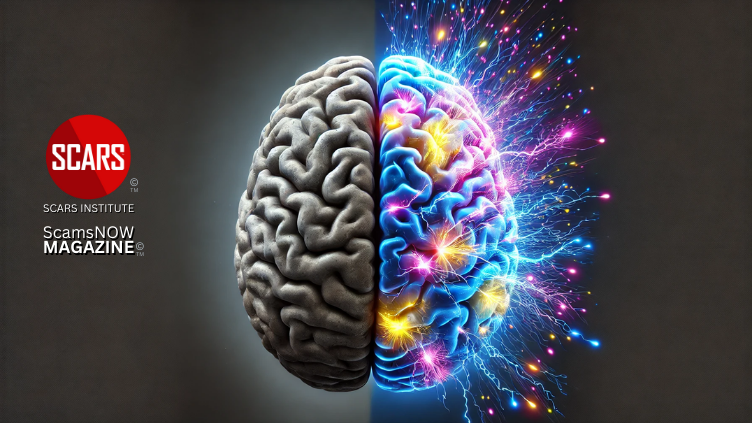Subliminal Messaging and Scams – A Deeper Look
How Scammer’s Subliminal Messaging Works on the Brain of Scam Victims: An In-Depth Exploration
Part 2 of a 2-Part Series – Part 1 is on RomanceScamsNOW.com
Primary Category: Psychology of Scams
Authors:
• Vianey Gonzalez B.Sc(Psych) – Licensed Psychologist, Specialty in Crime Victim Trauma Therapy, Neuropsychologist, Certified Deception Professional, Psychology Advisory Panel & Director of the Society of Citizens Against Relationship Scams Inc.
• Tim McGuinness, Ph.D., DFin, MCPO, MAnth – Anthropologist, Scientist, Polymath, Director of the Society of Citizens Against Relationship Scams Inc.
About This Article
Subliminal messaging works by presenting stimuli—whether visual or auditory—that are below the threshold of conscious awareness, meaning they are perceived subconsciously. The brain processes these inputs using sensory systems like the visual and auditory cortices, while regions such as the amygdala and hippocampus handle emotional responses and memory integration.
These subliminal messages can influence thoughts, emotions, and behaviors by activating existing associations or “priming” the brain for specific actions. Scammers use these techniques to manipulate victims in relationship scams, embedding subtle emotional triggers in their communication to deepen control.

How Scammer’s Subliminal Messaging Works on the Brain of Scam Victims: An In-Depth Exploration
Subliminal messaging has long intrigued scientists, advertisers, and the general public. Though the effectiveness of subliminal messages remains a topic of debate with some, the theoretical framework of how these messages are believed to work in the human brain reveals fascinating insights into the power of subconscious influence. Subliminal messaging operates below the threshold of conscious awareness, making it a subtle yet potentially powerful tool for influencing thoughts, behaviors, and emotions. In this article, we’ll explore how subliminal messaging works on the brain, what scientific theories support its potential, and the factors that can affect its effectiveness.
What is Subliminal Messaging?
Subliminal messaging refers to the practice of presenting stimuli—such as visual or auditory cues—so briefly or faintly that they are not consciously detected by the individual. These messages are designed to be processed by the subconscious mind, bypassing conscious awareness. The core idea is that the subconscious mind can still perceive and store information that the conscious mind misses, which can influence future behavior and decision-making without the individual being fully aware.
Theoretical Framework Behind Subliminal Messaging
Understanding how subliminal messaging works requires delving into the dual-processing theory of the brain. This theory outlines two primary systems through which the brain processes information:
- Conscious/Explicit System: This system is deliberate, rational, and aware. It processes information actively, analyzing and reasoning based on the data received. When you are consciously thinking about a decision or focusing on a task, you are using this explicit system.
- Subconscious/Implicit System: This system operates automatically, intuitively, and without conscious awareness. It processes large amounts of information without requiring the individual’s focused attention. This is the system responsible for gut feelings, automatic behaviors, and background processing of information.
Subliminal messaging functions by tapping into the subconscious system, below what is known as the “threshold of conscious awareness.” This is the level at which stimuli are strong enough to be consciously detected. If a message or stimulus is presented below this threshold, it can still be perceived by the brain, just not in a way that enters conscious awareness.
How Subliminal Messaging Works in the Brain
The process of subliminal messaging can be broken down into several stages:
Perception
The first step is presenting a subliminal message to an individual. This could be a visual cue (such as a fleeting image or symbol) or an auditory cue (such as a quick word or tone) that is too faint or brief to be consciously noticed. Despite this, the brain still perceives the message through its sensory systems.
Subconscious Processing
Once the message is perceived, the subconscious mind takes over. The subconscious brain processes the information without the individual becoming consciously aware of it. Unlike the conscious mind, which analyzes information deliberately, the subconscious mind works quickly and efficiently, automatically analyzing the information and potentially storing it in memory.
How it works: The subconscious may analyze the subliminal message based on the individual’s prior experiences, beliefs, and emotional states. For example, if someone has a positive association with a particular word or image, their subconscious mind may amplify this association when exposed to a subliminal message containing it.
Activation of Associations
Subliminal messages can activate existing associations in the brain, linking the message to pre-existing memories, emotions, or behaviors. This process is known as “relational binding.” For example, a subliminal message showing an image of a luxury car may trigger an individual’s memories of success or wealth. Over time, these connections can become stronger, influencing the individual’s behavior and thoughts.
Influencing Thoughts, Feelings, and Behaviors
While the individual remains unaware of the subliminal message’s influence, it can still shape their attitudes, emotions, and decisions. Subliminal messaging is thought to “prime” individuals, making certain thoughts, feelings, or behaviors more likely to occur. For instance, a subliminal cue encouraging relaxation might reduce anxiety, or a message promoting motivation could increase focus on a task.
Key Factors Influencing Subliminal Messaging Effectiveness
Although subliminal messaging may have some influence on the brain, several key factors determine its effectiveness:
Intensity and Duration
Subliminal messages must be presented with enough strength to be processed by the brain, but not so much that they enter conscious awareness. This requires careful balance, as the brain can easily dismiss weak stimuli that don’t leave a lasting impression.
Individual Differences
Personality traits, emotional states, and prior experiences play a significant role in determining how susceptible a person is to subliminal messages. People who are more open to suggestion, or who have strong emotional connections to the subliminal content, may be more easily influenced.
Relevance and Emotive Content
Subliminal messages that resonate with an individual’s personal values, desires, or emotions are more likely to have an impact. For example, a subliminal message promoting wealth might be more effective for someone who is financially motivated.
Context and Environment
The setting in which subliminal messages are presented can also affect their effectiveness. In a calm, focused environment, the brain may be more open to subtle suggestions, while in a chaotic or stressful environment, it may be harder for subliminal cues to take root.
The Psychological Impact of Subliminal Messaging
The psychological effects of subliminal messaging are still not fully understood. However, research suggests that subliminal stimuli can influence behavior and emotions, even if the individual is unaware of the message. The subconscious mind is constantly absorbing and processing information, and subliminal messages can subtly shape attitudes or reinforce pre-existing beliefs.
For example, subliminal messages related to relaxation may help reduce stress levels without the individual consciously realizing the cause. Similarly, subliminal cues tied to motivation might increase a person’s focus or productivity in certain situations.
However, the true depth of subliminal messaging’s effects, especially over the long term, remains a subject of debate among scientists. Some argue that its influence is fleeting, while others believe it could have a more profound impact on behavior and decision-making.
How Relationship Scammers Use Subliminal Messaging to Control Their Victims
Relationship scams, such as romance scams, have become increasingly sophisticated, with scammers leveraging psychological tactics to manipulate and control their victims. One particularly insidious technique that can be used in these scams is subliminal messaging. By embedding subtle cues or hidden messages in their communication, scammers can influence their victims’ emotions, thoughts, and behaviors without the victims being fully aware of the manipulation. These subliminal tactics can deepen the emotional bond between scammer and victim, making it even more difficult for the victim to recognize the scam and break free from the cycle of deception.
Emotional Music and Audio Cues
Scammers often use romantic songs or playlists to evoke emotional responses from their victims. By sending music that speaks of love, loneliness, or longing, the scammer taps into the victim’s emotional state, reinforcing the illusion of a deep emotional connection. Subliminally, the victim begins to associate these positive or sentimental emotions with the scammer, even though the relationship is fabricated.
How it works: The subconscious mind responds to music on an emotional level. Certain tones, rhythms, and lyrics can trigger dopamine release, creating a feeling of pleasure or attachment. Victims may not realize that their emotional response to the music is deepening their perceived bond with the scammer, making them more susceptible to further manipulation.
Subliminal Language in Messages
Scammers often use flowery, poetic language designed to bypass logical scrutiny and appeal directly to the victim’s emotions. They may embed subliminal cues within their written communication, such as repeating key words or phrases that evoke trust, love, or security. Over time, this consistent use of positive reinforcement subtly shifts the victim’s perception, convincing them that the relationship is genuine.
How it works: Subliminal messaging in language involves planting emotional triggers, such as words or phrases that invoke love, care, or trust. The victim’s subconscious mind begins to associate these words with the scammer, reinforcing feelings of affection and reducing skepticism about the relationship.
Visual Cues in Photos and Videos
Scammers frequently send photos of themselves (or stolen images of others) to create a visual connection with the victim. These images are often carefully curated to present an idealized version of the scammer—attractive, caring, and trustworthy. In some cases, scammers may include subliminal visual cues, such as specific poses, colors, or settings that evoke emotions like warmth, safety, or romance. Over time, these visual messages reinforce the victim’s emotional attachment to the scammer, even if they’ve never met in person.
How it works: The brain processes visual information quickly and often at a subconscious level. When victims repeatedly see images of someone they believe to be their romantic partner, they subconsciously form an emotional bond. The subtle details within these images, such as smiling faces, warm colors, or familiar settings, enhance the illusion of intimacy and trust.
Mirroring Emotional States
Another way scammers can use subliminal messaging to control victims is through emotional mirroring. Scammers often reflect the emotions expressed by the victim, whether it’s happiness, sadness, or anxiety. By aligning their own emotions with the victim’s, scammers create a sense of shared experience, making the victim feel understood and connected on a deeper level.
How it works: Emotional mirroring works on a subconscious level by creating a psychological phenomenon known as rapport. When someone mimics your emotions, it makes you feel more connected to them, as though they truly understand your feelings. In a relationship scam, this deepens the victim’s attachment to the scammer, making them less likely to question the authenticity of the relationship.
Subliminal Suggestions of Urgency or Need
In many relationship scams, the scammer will eventually ask for financial assistance, often under the guise of a sudden emergency or dire need. Subliminal messaging can enhance this request by embedding subtle suggestions of urgency or danger in the communication. For instance, using language that subtly invokes fear or guilt—such as implying that the scammer’s life is at risk or that they’ll lose something important—can manipulate the victim into responding without fully considering the situation.
How it works: Subliminal suggestions of urgency exploit the victim’s emotional state, triggering fear, guilt, or responsibility. The subconscious mind processes these emotional cues faster than the conscious mind can rationally assess the situation, leading the victim to act impulsively, often sending money to the scammer to alleviate the perceived danger or guilt.
Why Subliminal Messaging Works in Relationship Scams
Subliminal messaging is effective in relationship scams because it taps into the victim’s subconscious mind, where emotions are processed. Scammers exploit human desires for love, connection, and security, using subliminal cues to reinforce the illusion of a genuine relationship. These techniques often go unnoticed by the victim because they are designed to operate below the level of conscious awareness.
Victims may feel a strong attachment to the scammer without fully understanding why they trust someone they have never met. By the time the scammer begins to make demands—whether for money, personal information, or other favors—the victim is already emotionally invested, making it difficult for them to recognize the manipulation or walk away from the relationship.
Can Scammers Embed Subliminal Messaging in Photos or Videos, and How Might They Do It?
Scammers can also embed subliminal messaging in photos and videos, exploiting the unsuspecting nature of these media formats to manipulate their victims. As said above, subliminal messaging involves embedding information or cues below the threshold of conscious awareness.
When used in visual and auditory content, these hidden elements can influence an individual’s thoughts, emotions, and behaviors without them being fully aware. Scammers can take advantage of this subtle form of persuasion to deepen their control over victims, particularly in romance scams, investment fraud, or phishing schemes.
Here’s how scammers might embed subliminal messaging in photos or videos:
Embedding Subliminal Images or Text in Videos
One of the most common ways to embed subliminal messages in videos is through rapid frame insertion—the technique of placing a single frame or a series of frames containing a specific image or text that appears too quickly for conscious detection. This tactic has been used in advertising, and scammers can adopt it to plant subliminal cues in the minds of their victims.
How it works: Videos run at a specific frame rate (e.g., 24 to 30 frames per second). Scammers can insert images or messages that flash for just one or two frames—too fast for the viewer to consciously notice but long enough for the brain to process subliminally. These images could include text like “trust me” or visual symbols that represent security, romance, or urgency, priming the viewer to trust the scammer or make impulsive decisions.
Manipulating Audio in Videos
Scammers could also use subliminal audio techniques within a video or voice message. By embedding faint, inaudible messages behind the main audio track, they could influence the subconscious mind of the victim. These messages may be played at frequencies outside the normal hearing range or layered at a volume so low that the conscious mind doesn’t detect them, but the brain processes the information subliminally.
How it works: Audio manipulation involves adding very soft spoken words or tones in the background of a video, often masked by louder sounds or music. For example, scammers might include faint suggestions like “send money,” “act now,” or “you can trust me” below the conscious auditory threshold, making the victim more susceptible to their influence without realizing it.
Subliminal Cues in Photos
In still images, scammers can use subtle visual cues designed to evoke certain emotions or responses. While subliminal text and symbols in images might be harder to disguise compared to videos, scammers can manipulate aspects of the image in ways that affect the viewer subconsciously.
Use of color psychology
Colors have a significant impact on human emotions and perceptions. Scammers might deliberately use certain colors that evoke trust, love, or urgency. For instance, blue is often associated with calm and trust, while red can create feelings of urgency or passion. By carefully choosing color schemes, scammers can subliminally influence the victim’s emotional response to an image.
Symbolism and suggestive imagery
Scammers might include hidden symbols or objects within a photograph that have subconscious associations with safety, romance, or wealth. For example, a scammer posing as a romantic interest might send a photo where they are subtly holding a rose (symbolizing love) or standing next to a luxury car (symbolizing wealth and success). These visual details might not be consciously recognized by the victim but can still evoke strong emotional associations.
Visual Patterns or Shapes
Another way to embed subliminal messages in photos or videos is through the strategic placement of shapes or patterns. The brain is naturally wired to detect patterns, even if they are subtle or seemingly random. Scammers could exploit this by embedding certain shapes or patterns in the background of photos or in transitional frames of videos.
How it works: Subliminal shapes or patterns, such as hearts, arrows, or circular symbols, can be blended into the background of an image or video, influencing the viewer’s subconscious perception of love, movement, or connection. These shapes may not be consciously noticed but can still affect how the victim feels about the image or video.
Using AI-Generated Content
With the rise of AI tools, such as ControlNet and Stable Diffusion, scammers can now create highly customized and detailed images or videos that contain subliminal messages. AI-generated content allows for precise control over every aspect of the image or video, making it easier to embed subtle visual cues or hidden symbols without arousing suspicion.
How it works: AI tools can be used to generate faces, backgrounds, or even entire videos with specific hidden cues designed to influence the viewer. For example, in a romance scam, AI-generated videos might include subliminal text or background visuals that subtly reinforce trust or affection, deepening the victim’s emotional connection to the scammer.
Flashing Text or Icons in Social Media Posts
Scammers might also use subliminal techniques in social media posts, where images or short videos are frequently shared. By embedding flashing text or rapidly displayed icons in posts, they can prime victims to feel more connected to the scammer or prompt them to take specific actions (such as clicking a link or sending money).
How it works: In a post designed to look like a personal message or story, scammers can embed quick flashes of text or emojis that prompt emotions like love (hearts), urgency (stopwatches), or trust (handshakes). These flashes may be too quick for the user to consciously detect, but their subconscious mind will pick up on the suggestion.
Why Subliminal Messaging Works in Scams
The effectiveness of subliminal messaging lies in its ability to bypass the conscious mind and speak directly to the subconscious. The subconscious brain is always active, processing large amounts of information, even when the conscious mind is not aware. Subliminal messages, whether visual or auditory, can influence decisions, emotions, and behaviors by embedding suggestions that the victim doesn’t actively notice.
In scams, particularly romance scams or investment frauds, this influence can be especially powerful. Victims who are emotionally vulnerable or already invested in the relationship or scheme are more susceptible to these subliminal cues. The messages can amplify their existing feelings of trust, love, or urgency, making them more likely to ignore red flags or take impulsive actions, such as sending money or sharing personal information.
How Subliminal Messaging is Introduced into the Brain and the Brain Systems Involved
Subliminal messaging operates by subtly influencing the brain’s processing systems without the individual’s conscious awareness. This technique relies on stimuli—whether visual, auditory, or other sensory inputs—that are perceived below the threshold of conscious recognition, meaning they are too faint or brief for the conscious mind to detect. However, the brain still processes these stimuli at a subconscious level, which can then influence thoughts, emotions, and behaviors. Let’s explore in detail how subliminal messaging is introduced into the brain and the key brain systems involved in this process.
Introduction of Subliminal Stimuli
Subliminal messaging works by presenting sensory inputs—images, sounds, or words—below the threshold of conscious perception. These stimuli may appear for such a brief duration (e.g., milliseconds) or at such low intensity (e.g., very faint sound) that the conscious mind does not register them, but the subconscious mind can still detect and process the information.
-
-
- Visual Subliminal Messaging: This involves presenting visual stimuli such as words, symbols, or images too quickly or subtly for the conscious mind to detect. These stimuli might be embedded in videos, flashed rapidly on screens, or hidden in the background of images.
- Auditory Subliminal Messaging: This uses sounds or words at a volume below the level of conscious hearing. It might involve faint whispers layered under music or ambient noise, or speech played at frequencies outside the conscious auditory range.
-
Processing by the Subconscious Mind
Once subliminal stimuli are introduced, the brain’s subconscious processing system begins to take over. While the conscious mind remains unaware of the stimuli, the subconscious mind registers and processes this information. This process can occur through various sensory pathways, involving specialized regions in the brain dedicated to visual, auditory, and emotional processing.
Brain Systems Involved in Subliminal Processing
Sensory Systems: The brain’s primary sensory cortices (responsible for vision, hearing, touch, etc.) are the first regions to receive and process subliminal inputs.
-
-
-
- Visual Cortex (Occipital Lobe): When subliminal visual messages are introduced, the retina sends signals to the visual cortex, located at the back of the brain. Even if the visual stimulus is too quick to be consciously registered, it still reaches the visual cortex and is processed at a subconscious level.
- Auditory Cortex (Temporal Lobe): Subliminal auditory messages are processed by the auditory cortex in the temporal lobe. Even if the sound is below conscious hearing, the auditory cortex picks up the signal and sends it through further processing pathways.
-
-
Amygdala: Emotional Processing Center The amygdala plays a crucial role in emotional responses and the subconscious processing of emotions. It is particularly sensitive to subliminal stimuli that evoke emotional reactions, such as fear, trust, love, or anxiety. The amygdala can respond to subliminal messages that contain emotionally charged content, even when the individual is not consciously aware of the stimulus.
For example, in romance scams, subliminal cues that evoke feelings of trust, love, or attachment could be processed by the amygdala, triggering emotional responses that make the victim feel more connected to the scammer. These emotional responses are subconscious and automatic, often influencing behavior without the victim realizing why.
Hippocampus: Memory Integration The hippocampus, which is part of the brain’s memory system, plays a key role in integrating subliminal stimuli into long-term memory. This is known as relational binding, where the hippocampus links subliminal inputs with existing memories or experiences, forming new associations that influence future behavior. For example, subliminal cues that are linked to past experiences of love or success may reinforce those memories and drive subconscious decisions.
In the case of subliminal messaging, even when the individual does not consciously remember seeing or hearing a subliminal message, the hippocampus might store the information and retrieve it later to influence decision-making or behavior.
Prefrontal Cortex: Decision-Making and Behavior The prefrontal cortex, responsible for higher-order decision-making and rational thinking, is often indirectly influenced by subliminal stimuli. Although subliminal messages do not directly engage the prefrontal cortex, they can prime the brain by activating associations that the prefrontal cortex later draws upon when making decisions.
For example, a subliminal message promoting urgency (such as “act now” in a crypto scam) might not be consciously recognized, but it subtly influences the prefrontal cortex when the individual is deciding whether to invest. The victim feels a heightened sense of urgency, making it more likely they will make impulsive decisions without fully rationalizing the situation.
Activation of Associations and Priming
Subliminal messages work by activating associations that are already stored in the brain. This process is called priming, where exposure to a subliminal cue makes certain thoughts, feelings, or behaviors more likely to occur later. Priming operates below conscious awareness, subtly nudging the individual toward specific actions or emotions.
How it works: Subliminal messages may activate existing memories, emotions, or learned behaviors. For example, a victim of a romance scam may have previous positive associations with love, companionship, or financial success. A subliminal message embedded in a photo or conversation can tap into these associations, making the victim more likely to trust the scammer or act in ways that align with the scammer’s goals.
The amygdala and hippocampus are both involved in this process. The amygdala links the subliminal message to emotional reactions, while the hippocampus binds the message to existing memories, reinforcing patterns of behavior or thought.
Influencing Behavior and Decision-Making
Once the subliminal message is processed and associated with emotions or memories, it can subtly influence behavior and decision-making. The brain integrates subliminal messages with ongoing conscious thoughts, making certain behaviors or emotional reactions more likely to occur.
-
-
- Priming the Brain for Action: Subliminal messaging works by priming the brain to respond in certain ways. For instance, if a subliminal message suggests trust, the victim might feel an unconscious sense of confidence in the scammer, making them more likely to send money or share personal information.
- Influencing Emotional States: Subliminal cues can also influence emotional states such as anxiety, fear, or affection. For example, subliminal messaging in blackmail scams might intensify feelings of guilt or shame, making the victim more susceptible to the scammer’s demands.
-
The Brain Systems Involved in Subliminal Messaging
Subliminal messaging exploits the brain’s natural processing systems to influence behavior and decision-making without conscious awareness. The visual and auditory systems initially process the subliminal stimuli, while the amygdala, hippocampus, and prefrontal cortex integrate these cues into emotional reactions, memory formation, and decision-making processes. By bypassing the conscious mind and targeting the subconscious, subliminal messaging taps into deep psychological mechanisms, subtly shaping thoughts, emotions, and behaviors. Although the exact effects of subliminal messaging are still debated, the brain systems involved suggest that it can have a powerful influence on individuals, especially in emotionally charged situations like scams.
Debates and Ethical Concerns
While subliminal messaging is a fascinating psychological phenomenon, its use raises significant ethical concerns. The potential for manipulation is particularly worrisome in fields such as advertising, political messaging, and media, where individuals could be unknowingly influenced to adopt certain attitudes or behaviors. This raises important questions about consent and the morality of using subliminal techniques for persuasion.
In advertising, for example, companies may try to implant subconscious desires for their products. In politics, subliminal messaging could be used to sway voter opinions. Without the ability to recognize or resist these messages, individuals are left vulnerable to external influence that they cannot consciously defend against.
However, recent scientific studies indicate that subliminal messages can be more powerful than previously thought. To learn more view our article on RomanceScamsNOW.com: Subliminal Messaging: A New Scammer’s Tool Against Scam Victims – 2024
Summary
Subliminal messaging presents an intriguing blend of psychology, neuroscience, and human behavior. While still a subject of debate, the mechanisms through which subliminal messages operate suggest that the subconscious mind is far more active and influential than previously thought. Subliminal messaging works by bypassing the conscious mind and embedding suggestions directly into the subconscious, potentially influencing behavior, emotions, and decision-making.
Subliminal messaging is a powerful tool that scammers use to manipulate their victims in relationship scams. Through carefully crafted emotional cues, evocative language, visual manipulation, and psychological tactics like mirroring, scammers can deeply influence a victim’s emotions, thoughts, and behaviors without the victim being fully aware. Understanding how subliminal messaging works can help individuals better recognize the signs of manipulation in online relationships, empowering them to protect themselves from falling victim to these highly sophisticated scams.
However, its effectiveness depends on various factors, including individual differences, the message’s intensity, and the context in which it is presented. As research continues to evolve, it is crucial to consider both the potential benefits and ethical challenges posed by subliminal messaging, particularly in fields where unconscious influence could be used for manipulation or control.
Scammers can indeed embed subliminal messaging in photos or videos, using various psychological tactics to manipulate their victims without their conscious awareness. By utilizing visual cues, rapid frame changes, audio manipulation, and AI-generated content, scammers can subtly influence emotions, thoughts, and behaviors, deepening the victim’s susceptibility to the scam. Understanding how these subliminal tactics work is critical for individuals to protect themselves from manipulation in online interactions, especially in the increasingly sophisticated world of digital fraud.
About the Above SCARS Institute Information
The foregoing is not intended to be completed research itself but rather to report on SCARS Institute’s ongoing research and to offer suggestions to other institutions regarding areas where additional research might be conducted. This summary aims to highlight key findings and propose potential avenues for further investigation, contributing to a broader understanding of the subject matter and encouraging continued exploration within the field.
If you would like more information or to collaborate on research studies or projects please contact the SCARS Institute at contact@AgainstScams.org
Please Rate This Article
Please Leave Us Your Comment Below
Also, tell us of any topics we might have missed.
-/ 30 /-
What do you think about this?
Please share your thoughts in a comment above!
-/ 30 /-
What do you think about this?
Please share your thoughts in a comment above!
ARTICLE RATING
TABLE OF CONTENTS
- How Scammer’s Subliminal Messaging Works on the Brain of Scam Victims: An In-Depth Exploration
- About This Article
- How Scammer’s Subliminal Messaging Works on the Brain of Scam Victims: An In-Depth Exploration
- What is Subliminal Messaging?
- Theoretical Framework Behind Subliminal Messaging
- How Subliminal Messaging Works in the Brain
- Key Factors Influencing Subliminal Messaging Effectiveness
- The Psychological Impact of Subliminal Messaging
- How Relationship Scammers Use Subliminal Messaging to Control Their Victims
- Why Subliminal Messaging Works in Relationship Scams
- Can Scammers Embed Subliminal Messaging in Photos or Videos, and How Might They Do It?
- Why Subliminal Messaging Works in Scams
- How Subliminal Messaging is Introduced into the Brain and the Brain Systems Involved
- Debates and Ethical Concerns
- Summary
- About the Above SCARS Institute Information
CATEGORIES
U.S. & Canada Suicide Lifeline 988
![NavyLogo@4x-81[1] Subliminal Messaging and Scams - A Deeper Look - 2024](https://scamsnow.com/wp-content/uploads/2025/04/NavyLogo@4x-811.png)
ARTICLE META
Important Information for New Scam Victims
- Please visit www.ScamVictimsSupport.org – a SCARS Website for New Scam Victims & Sextortion Victims.
- SCARS Institute now offers its free, safe, and private Scam Survivor’s Support Community at www.SCARScommunity.org – this is not on a social media platform, it is our own safe & secure platform created by the SCARS Institute especially for scam victims & survivors.
- SCARS Institute now offers a free recovery learning program at www.SCARSeducation.org.
- Please visit www.ScamPsychology.org – to more fully understand the psychological concepts involved in scams and scam victim recovery.
If you are looking for local trauma counselors, please visit counseling.AgainstScams.org
If you need to speak with someone now, you can dial 988 or find phone numbers for crisis hotlines all around the world here: www.opencounseling.com/suicide-hotlines
Statement About Victim Blaming
Some of our articles discuss various aspects of victims. This is both about better understanding victims (the science of victimology) and their behaviors and psychology. This helps us to educate victims/survivors about why these crimes happened and not to blame themselves, better develop recovery programs, and help victims avoid scams in the future. At times, this may sound like blaming the victim, but it does not blame scam victims; we are simply explaining the hows and whys of the experience victims have.
These articles, about the Psychology of Scams or Victim Psychology – meaning that all humans have psychological or cognitive characteristics in common that can either be exploited or work against us – help us all to understand the unique challenges victims face before, during, and after scams, fraud, or cybercrimes. These sometimes talk about some of the vulnerabilities the scammers exploit. Victims rarely have control of them or are even aware of them, until something like a scam happens, and then they can learn how their mind works and how to overcome these mechanisms.
Articles like these help victims and others understand these processes and how to help prevent them from being exploited again or to help them recover more easily by understanding their post-scam behaviors. Learn more about the Psychology of Scams at www.ScamPsychology.org
SCARS INSTITUTE RESOURCES:
If You Have Been Victimized By A Scam Or Cybercrime
♦ If you are a victim of scams, go to www.ScamVictimsSupport.org for real knowledge and help
♦ SCARS Institute now offers its free, safe, and private Scam Survivor’s Support Community at www.SCARScommunity.org – this is not on a social media platform, it is our own safe & secure platform created by the SCARS Institute especially for scam victims & survivors.
♦ Enroll in SCARS Scam Survivor’s School now at www.SCARSeducation.org
♦ To report criminals, visit https://reporting.AgainstScams.org – we will NEVER give your data to money recovery companies like some do!
♦ Follow us and find our podcasts, webinars, and helpful videos on YouTube: https://www.youtube.com/@RomancescamsNowcom
♦ Learn about the Psychology of Scams at www.ScamPsychology.org
♦ Dig deeper into the reality of scams, fraud, and cybercrime at www.ScamsNOW.com and www.RomanceScamsNOW.com
♦ Scam Survivor’s Stories: www.ScamSurvivorStories.org
♦ For Scam Victim Advocates visit www.ScamVictimsAdvocates.org
♦ See more scammer photos on www.ScammerPhotos.com
You can also find the SCARS Institute’s knowledge and information on Facebook, Instagram, X, LinkedIn, and TruthSocial
Psychology Disclaimer:
All articles about psychology and the human brain on this website are for information & education only
The information provided in this and other SCARS articles are intended for educational and self-help purposes only and should not be construed as a substitute for professional therapy or counseling.
Note about Mindfulness: Mindfulness practices have the potential to create psychological distress for some individuals. Please consult a mental health professional or experienced meditation instructor for guidance should you encounter difficulties.
While any self-help techniques outlined herein may be beneficial for scam victims seeking to recover from their experience and move towards recovery, it is important to consult with a qualified mental health professional before initiating any course of action. Each individual’s experience and needs are unique, and what works for one person may not be suitable for another.
Additionally, any approach may not be appropriate for individuals with certain pre-existing mental health conditions or trauma histories. It is advisable to seek guidance from a licensed therapist or counselor who can provide personalized support, guidance, and treatment tailored to your specific needs.
If you are experiencing significant distress or emotional difficulties related to a scam or other traumatic event, please consult your doctor or mental health provider for appropriate care and support.
Also read our SCARS Institute Statement about Professional Care for Scam Victims – click here
If you are in crisis, feeling desperate, or in despair, please call 988 or your local crisis hotline.
More ScamsNOW.com Articles
A Question of Trust
At the SCARS Institute, we invite you to do your own research on the topics we speak about and publish. Our team investigates the subject being discussed, especially when it comes to understanding the scam victims-survivors’ experience. You can do Google searches, but in many cases, you will have to wade through scientific papers and studies. However, remember that biases and perspectives matter and influence the outcome. Regardless, we encourage you to explore these topics as thoroughly as you can for your own awareness.























![scars-institute[1] Subliminal Messaging and Scams - A Deeper Look - 2024](https://scamsnow.com/wp-content/uploads/2025/04/scars-institute1.png)
![niprc1.png1_-150×1501-1[1] Subliminal Messaging and Scams - A Deeper Look - 2024](https://scamsnow.com/wp-content/uploads/2025/04/niprc1.png1_-150x1501-11.webp)
